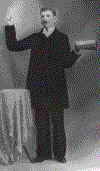A Brief History of the Pentecostal Holiness Church
Part Two
The Holiness Movement
When American Methodism was formed in 1784, the church accepted Wesley's mandate to "reform the continent and spread scriptural holiness over these lands." For over a century the holiness cause was promoted by Methodist preachers and churches throughout the nation. As the church grew larger and wealthier, however, the holiness testimony tended to fade as a distinctive teaching and experience in the church. Despite attempts to renew the holiness message in the church both before and after the Civil War, the trend away from holiness theology and experience was clearly established by the end of the nineteenth century.
The last major holiness revival among the Methodists and other mainline Protestant churches came after the formation of the National Holiness Association in Vineland, New Jersey, in 1867. But the resulting revival failed to bring the majority of the American church back to the holiness cause. When the Southern Methodist Church rejected the holiness movement in 1894, over 25 new holiness groups were formed in the United States dedicated to the promotion of holiness preaching and living.
The Pentecostal Holiness Church was one of those holiness groups in America which began after 1894 as a result of the controversies over the question of sanctification.
The Pentecostal Movement
During the last years of the nineteenth century, there arose a conviction among many fervent people in the holiness movement that a fresh outpouring of the Holy Spirit was the great need of the church. A general attitude of seeking for deeper and further spiritual grace seemed to permeate the movement as the new century was about to dawn. This cry for a "new pentecost" was experienced in both Europe and America.
The modern pentecostal movement had its origins in Topeka, Kansas, in a small Bible school conducted by Charles Fox Parham, a holiness evangelist who began his ministry as a Methodist pastor. In 1901, Agnes Ozman, a student at Parham's school, received the baptism in the Holy Spirit accompanied by speaking in tongues. Ozman was a member of the Fire Baptized Holiness Church, which merged with the Pentecostal Holiness Church in 1911.
The pentecostal movement received worldwide influence in 1906 in Los Angeles, California, in the Azusa Street revival led by the African-American holiness evangelist William Joseph Seymour. From Azusa Street, the pentecostal experience spread around the world as holiness people by the thousands received the pentecostal baptism with the Holy Ghost with the apostolic sign of speaking with other tongues.
Not since the days of the early church had any revival movement spread so quickly and so far. In every continent, holiness people flocked to altars to receive their own personal pentecost.
Once again the gifts of the Spirit were experienced by the church. The atmosphere of the book of Acts became the norm for the thousands of pentecostal churches and missions that appeared throughout the world. Everywhere, the restoration of the charismata was understood as proof positive that the second advent of Christ was near.
The Pentecostal Holiness Church was a part of this pentecostal outpouring. From the beginning it played a part in the unfolding drama of this third spiritual reformation of the church. Organized as a holiness denomination in 1898, the church officially incorporated the theology of the Pentecostal Reformation in its Articles of Faith in 1908 by adopting the following statement:
We believe the pentecostal baptism of the Holy Ghost and fire is obtainable by a definite act of appropriating faith on the part of the fully cleansed believer, and the initial evidence of the reception of this experience is speaking with other tongues as the Spirit gives utterance (Luke 11:13; Acts 1:5; 2:1-4; 8:17; 10:44-46; 19:6).
The Pentecostal Holiness Church also holds to the other basic doctrines of historic Christianity such as the Trinity, the deity, the virgin birth, and the second coming of Christ, and future rewards and punishments after the final judgment. It was, however, the distinctive doctrines of holiness and pentecost that gave birth to the denomination
Organizational Heritage

The first congregation to bear the name of the Pentecostal Holiness Church was organized in Goldsboro, North Carolina, in 1898 as a result of the evangelistic ministry of Abner Blackman Crumpler, a Methodist evangelist. In 1897 in Magnolia, North Carolina, Crumpler organized the inter- denominational North Carolina Holiness Association.
Because of his uncompromising holiness ministry, Crumpler was tried in 1899 in a Methodist ecclesiastical court for "preaching the glorious doctrines of Methodism," as he explained it. Although he was acquitted in the trial, Crumpler soon withdrew from the Methodist Church and with several followers began a new denomination which generally was called the Pentecostal Holiness Church.
In 1900 the church's first convention was conducted in Fayetteville, North Carolina, where Crumpler was elected to serve as president, and a Discipline was adopted. Several congregations were organized principally in North Carolina, South Carolina, and Virginia. In 1901 at Magnolia, North Carolina, the word pentecostal was eliminated from the name, and for eight years the church was known as The Holiness Church of North Carolina.
Following the outpouring of the Holy Spirit in 1906, and after many members received the baptism of the Spirit according to Acts 2:4, the word pentecostal was restored to the name at Falcon, North Carolina, in 1909.